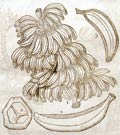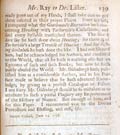Cabinet 03 - Pre-Linnaean Classification
 John Gerard or Gerarde (1545-1612) was born in Cheshire, England. Although gaining a reputation as a surgeon, he is better known for his Herball or Generall Historie of Plantes, first published in 1597. This work was more than a mere compilation. It recorded plants from the then accessible parts of the globe and offered medicinal qualities or the 'virtues' of plants. The 1633 edition was greatly enhanced by Thomas Johnson, a London apothecary and botanist. He added a further 800 plants and 700 more illustrations to the work. Many were new, such as the plantain or banana (Musa sapientum, Musaceae). Linnaeus honored Gerard in the name of the plant genus Gerardia.
John Gerard or Gerarde (1545-1612) was born in Cheshire, England. Although gaining a reputation as a surgeon, he is better known for his Herball or Generall Historie of Plantes, first published in 1597. This work was more than a mere compilation. It recorded plants from the then accessible parts of the globe and offered medicinal qualities or the 'virtues' of plants. The 1633 edition was greatly enhanced by Thomas Johnson, a London apothecary and botanist. He added a further 800 plants and 700 more illustrations to the work. Many were new, such as the plantain or banana (Musa sapientum, Musaceae). Linnaeus honored Gerard in the name of the plant genus Gerardia.
John Gerarde, The Herball or Generall Historie of Plantes. London: Adam Aslip, Joice Norton, and Richard Whitakers, 1633. DeB Ec 1633 G
 John Ray (1627–1705; formerly Wray), naturalist and theologian, is often termed the father of natural history in Britain. Like Linnaeus, he searched for the 'natural system', a classification of organisms that would reflect the Divine Order of creation. Unlike Linnaeus, he classified plants by overall morphology. He anticipated Marcello Malpighi by dividing flowering plants into monocotyledons and dicotyledons, and he firmly believed in the importance of essential, rather than accidental, characteristics in identifying a species. Prior to Historia Plantarum (1686; 1688), which is his most important work, he published Catalogus plantarum Angliae (2nd ed., 1677), which is referred to in this letter to Dr Martin Lister (1639-1712). The catalogue was praised for the extensive medical and pharmacological notes which accompanied the descriptions of plants.
John Ray (1627–1705; formerly Wray), naturalist and theologian, is often termed the father of natural history in Britain. Like Linnaeus, he searched for the 'natural system', a classification of organisms that would reflect the Divine Order of creation. Unlike Linnaeus, he classified plants by overall morphology. He anticipated Marcello Malpighi by dividing flowering plants into monocotyledons and dicotyledons, and he firmly believed in the importance of essential, rather than accidental, characteristics in identifying a species. Prior to Historia Plantarum (1686; 1688), which is his most important work, he published Catalogus plantarum Angliae (2nd ed., 1677), which is referred to in this letter to Dr Martin Lister (1639-1712). The catalogue was praised for the extensive medical and pharmacological notes which accompanied the descriptions of plants.
